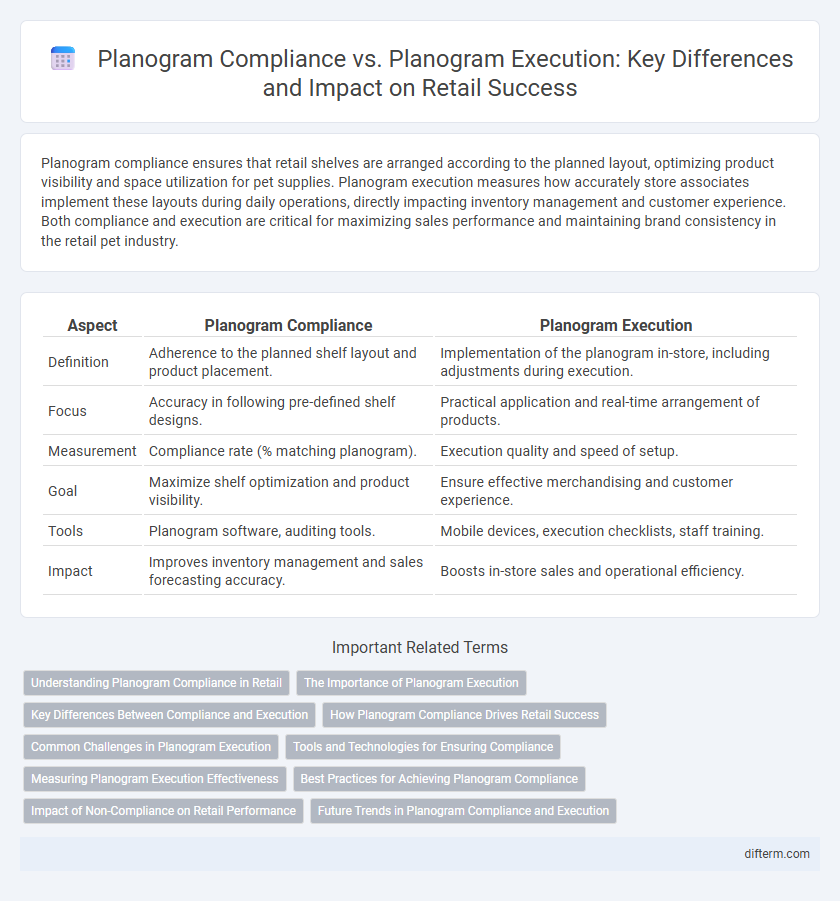Planogram compliance ensures that retail shelves are arranged according to the planned layout, optimizing product visibility and space utilization for pet supplies. Planogram execution measures how accurately store associates implement these layouts during daily operations, directly impacting inventory management and customer experience. Both compliance and execution are critical for maximizing sales performance and maintaining brand consistency in the retail pet industry.
Table of Comparison
| Aspect | Planogram Compliance | Planogram Execution |
|---|---|---|
| Definition | Adherence to the planned shelf layout and product placement. | Implementation of the planogram in-store, including adjustments during execution. |
| Focus | Accuracy in following pre-defined shelf designs. | Practical application and real-time arrangement of products. |
| Measurement | Compliance rate (% matching planogram). | Execution quality and speed of setup. |
| Goal | Maximize shelf optimization and product visibility. | Ensure effective merchandising and customer experience. |
| Tools | Planogram software, auditing tools. | Mobile devices, execution checklists, staff training. |
| Impact | Improves inventory management and sales forecasting accuracy. | Boosts in-store sales and operational efficiency. |
Understanding Planogram Compliance in Retail
Planogram compliance in retail measures how accurately store displays match the predefined planogram, which is essential for maximizing product visibility and sales. It involves consistent placement, correct product facings, and adherence to brand guidelines, ensuring a uniform shopping experience across all locations. High compliance rates directly influence inventory management efficiency and enhance overall merchandising effectiveness.
The Importance of Planogram Execution
Planogram execution ensures that products are displayed precisely as designed to maximize sales potential, directly impacting customer experience and inventory management. Accurate execution reduces out-of-stock situations and enhances visual merchandising, driving higher foot traffic and conversion rates. Consistent planogram execution strengthens brand consistency across retail locations, leading to improved overall profitability.
Key Differences Between Compliance and Execution
Planogram compliance refers to the degree to which store shelves align with the visual merchandising plan, ensuring products are placed exactly as specified to maximize visibility and sales. Planogram execution expands beyond compliance by incorporating factors such as inventory availability, staff training, and real-time adjustments to optimize product placement dynamically. The key differences lie in compliance's focus on adherence to preset layouts versus execution's emphasis on holistic, adaptable implementation in day-to-day retail operations.
How Planogram Compliance Drives Retail Success
Planogram compliance ensures that retail displays match the prescribed layout, optimizing product visibility and enhancing customer experience. High compliance rates directly correlate with increased sales and inventory accuracy by presenting products consistently and attractively. Retailers leveraging strict planogram adherence can better manage shelf space, reduce out-of-stock incidents, and drive overall business growth.
Common Challenges in Planogram Execution
Common challenges in planogram execution include inaccurate product placement due to human error, inconsistent shelf conditions, and difficulties in real-time monitoring of compliance. Retailers often face issues with insufficient training of staff on planogram standards and limited use of technology to verify proper execution. These obstacles hinder achieving optimal shelf organization, impacting inventory management and sales performance.
Tools and Technologies for Ensuring Compliance
Planogram compliance relies heavily on advanced tools such as shelf-scanning robots, image recognition software, and AI-driven analytics to accurately verify product placement against predefined layouts. Mobile applications equipped with real-time planogram validation and augmented reality visual guides empower store associates to execute planograms precisely on the sales floor. Cloud-based platforms integrated with IoT sensors enable continuous monitoring and automated alerts, enhancing the accuracy and efficiency of planogram execution in retail environments.
Measuring Planogram Execution Effectiveness
Measuring planogram execution effectiveness involves assessing how accurately products are displayed according to the predefined shelf layouts, ensuring optimal product placement and inventory management. Key metrics include shelf availability, product facings, and adherence to promotional displays, which directly impact sales performance and customer experience. Advanced analytics tools and real-time audits enhance visibility into execution gaps, enabling retailers to optimize shelf layouts and improve overall planogram compliance.
Best Practices for Achieving Planogram Compliance
Consistently achieving planogram compliance requires precise shelf layout audits and real-time inventory tracking through advanced retail execution software. Training frontline staff on visual merchandising standards enhances adherence to planogram specifications, directly boosting product visibility and sales. Leveraging mobile devices for instant feedback and corrective actions ensures that execution stays aligned with the predefined retail strategy.
Impact of Non-Compliance on Retail Performance
Planogram compliance ensures merchandise is displayed according to the retail strategy, directly influencing sales, inventory management, and customer experience. Non-compliance leads to misplaced products, reduced shelf space efficiency, and inconsistent brand presentation, resulting in lost revenue and lower customer satisfaction. Retailers experiencing poor planogram execution often face inventory shrinkage, increased stockouts, and diminished shopper loyalty, impacting overall business performance.
Future Trends in Planogram Compliance and Execution
Future trends in planogram compliance and execution emphasize the integration of AI-driven analytics and IoT-enabled shelf monitoring to enhance real-time accuracy and decision-making in retail environments. Advanced machine learning algorithms will predict consumer behavior patterns, optimizing product placement for increased sales and inventory efficiency. Retailers will increasingly adopt augmented reality tools and automated auditing systems to streamline compliance checks, reduce labor costs, and ensure consistent merchandising standards across multiple locations.
Planogram Compliance vs Planogram Execution Infographic

 difterm.com
difterm.com